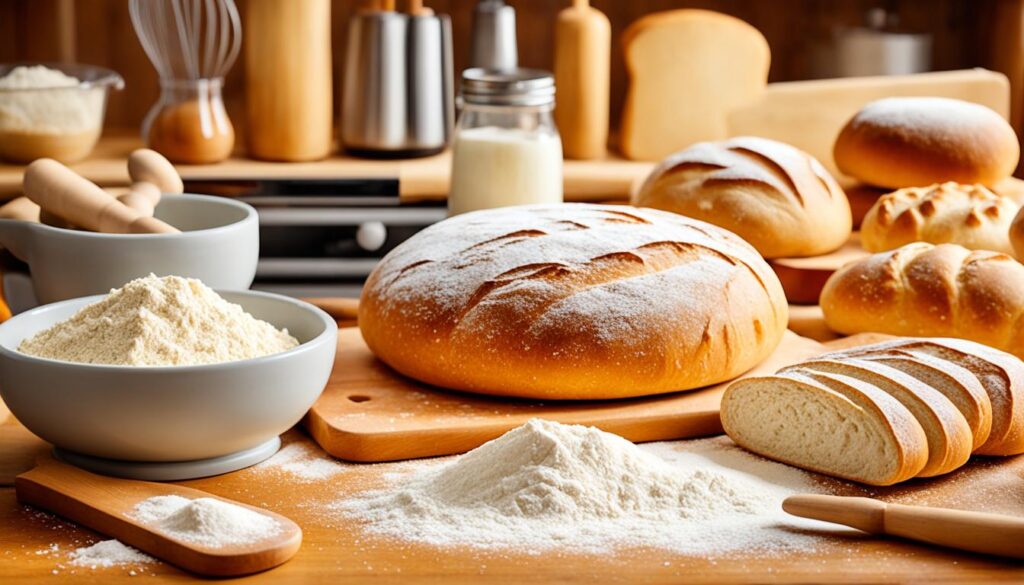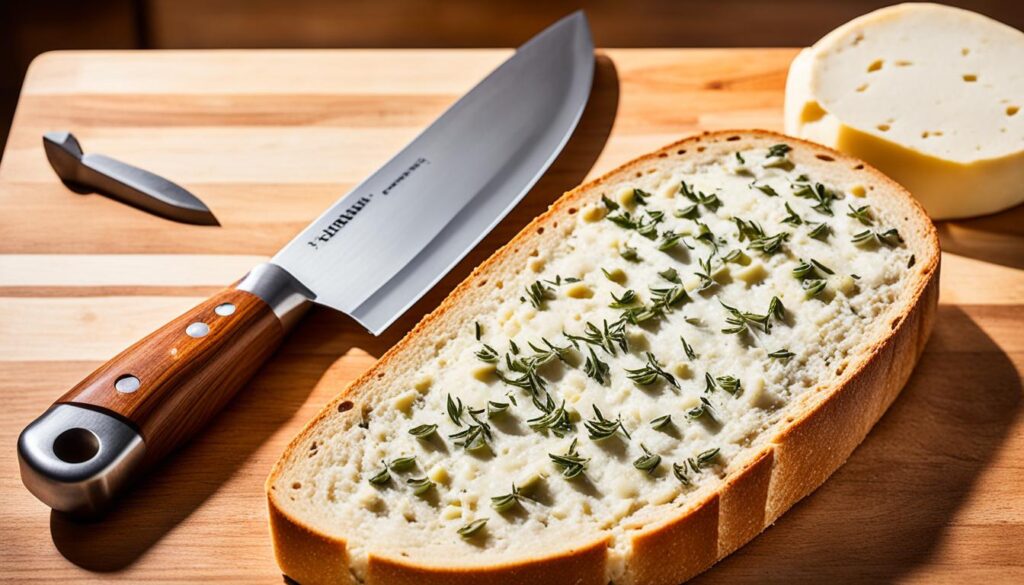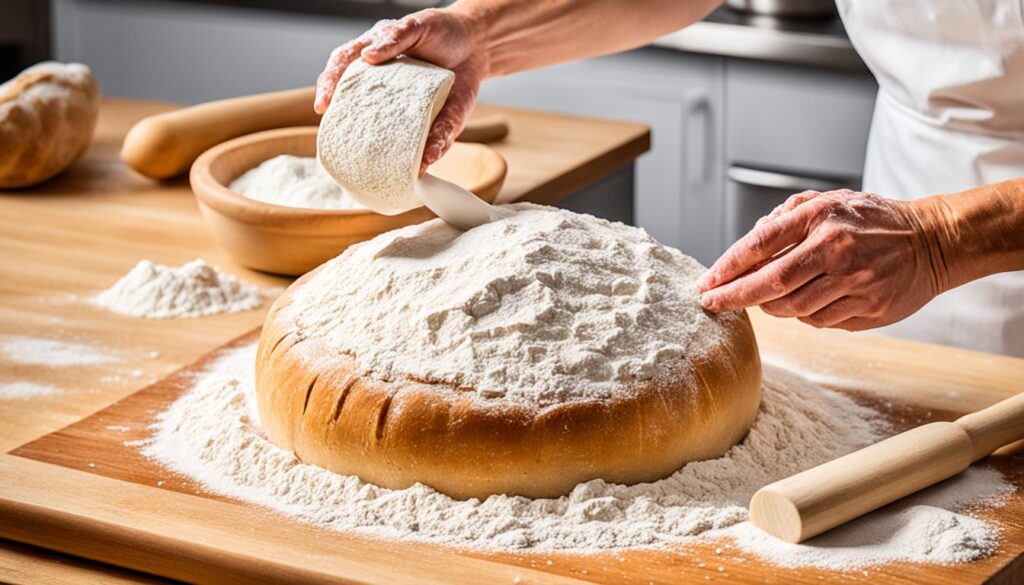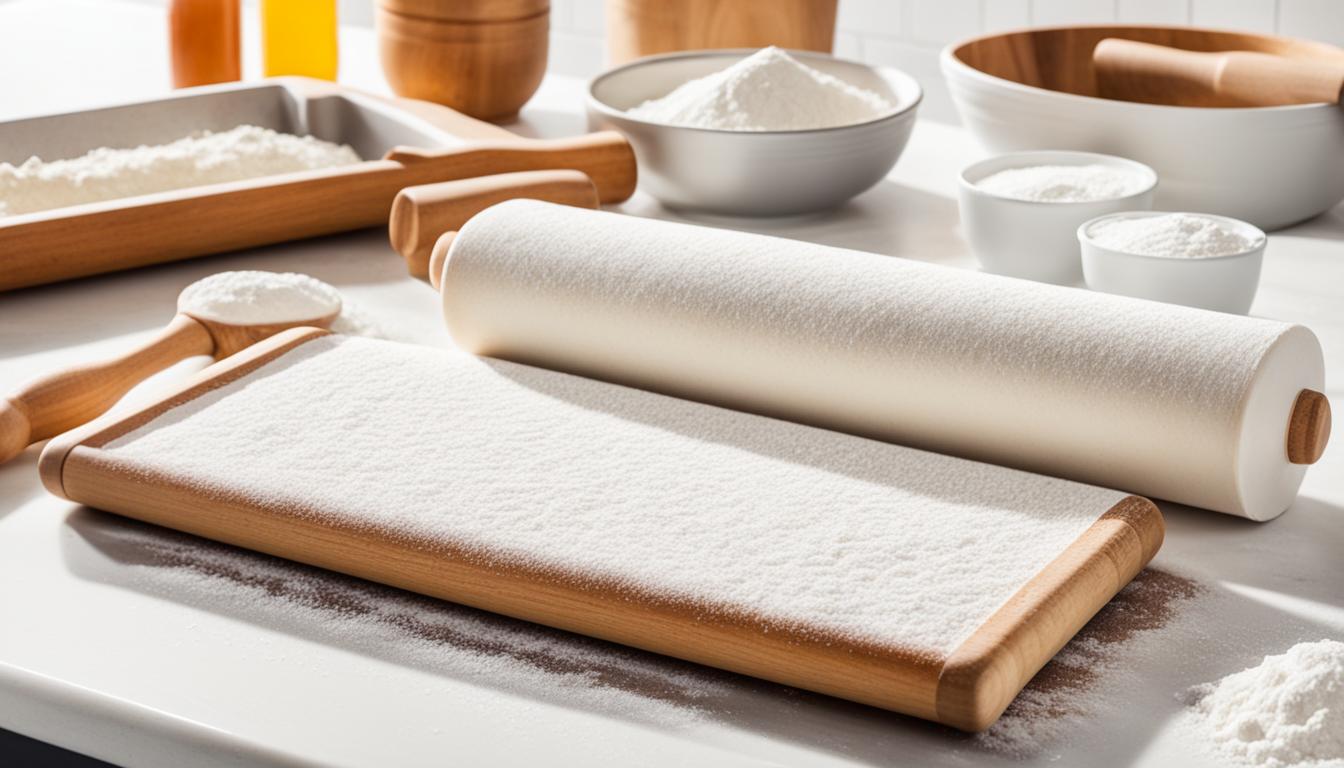Are you tired of store-bought bread that never quite satisfies your craving for homemade goodness? Do you want to create your own mouthwatering loaves with your own two hands? If so, you’re in luck! We’ve got all the tools you need to make great bread at home.
Whether you’re a seasoned bread baking pro or a newbie in the kitchen, having the right tools at your disposal can make a world of difference in the quality and outcome of your homemade bread. From mixing and kneading to proofing and shaping, having the right equipment can streamline the bread making process and help you achieve that perfect crust and crumb.
In this article, we’ll explore the essential bread making tools every home baker needs. From the must-haves to the specialized tools for specific bread types, we’ll cover it all. So, are you ready to dive into the world of homemade bread and discover the tools that will elevate your baking game?
Key Takeaways:
- All the tools you need to make great bread at home
- Equip yourself with the bread making essentials
- Discover the indispensable homemade bread equipment
- Master the art of bread making with the right tools
- Level up your baking game with these essential tools
Sourdough Starter Tools
Creating and maintaining a sourdough starter requires a few essential tools that can help you achieve the best results. Here are some sourdough starter tools that we recommend:
1. Good Scale
Accurate measurements are crucial when it comes to creating a sourdough starter. A good scale ensures that you use the right proportions of flour and water, resulting in a healthy and active starter.
2. Spatula
A sturdy spatula is essential for mixing and stirring the ingredients when feeding your sourdough starter. Look for a spatula made of food-safe materials that can withstand frequent use and be easy to clean.
3. Temperature Control Guide
Maintaining the right temperature is vital for sourdough starter development. A temperature control guide, such as a digital thermometer or a temperature probe, helps you monitor and adjust the temperature of your starter to ensure optimal fermentation.
4. Glass Jar or Container
A glass jar or container with a tight-fitting lid is an ideal choice for storing your sourdough starter. It allows you to observe and monitor its growth while preventing any external contaminants from entering.
5. Clean Kitchen Towel or Cheesecloth
Covering your jar with a clean kitchen towel or cheesecloth allows air circulation while keeping dust and insects away from your sourdough starter. It’s important to choose a breathable fabric that won’t restrict the fermentation process.
6. Marker or Labeling Tape
Labeling your sourdough starter jar with the date and time of each feeding helps you keep track of its progress. A marker or labeling tape is a simple tool that ensures you don’t lose track of when you’ve last fed your starter.
Tip: Maintaining a consistent feeding schedule and temperature is key to developing a strong and flavorful sourdough starter.
7. Discard Container
During the feeding process, you’ll need a container to store the discarded portions of your sourdough starter. This container should be separate from the one used for the active starter and can be used for other baking projects or even composting.
Here’s a table summarizing the sourdough starter tools:
| Tool | Description |
|---|---|
| Good Scale | Accurate measurements for the sourdough starter. |
| Spatula | Sturdy utensil for mixing and stirring the starter. |
| Temperature Control Guide | Tool to monitor and adjust the starter’s temperature. |
| Glass Jar or Container | Container for storing the sourdough starter. |
| Clean Kitchen Towel or Cheesecloth | Breathable cover to protect the starter. |
| Marker or Labeling Tape | Tool for labeling and tracking the starter’s feedings. |
| Discard Container | Container for storing the discarded portions of the starter. |
Basic Bread Baking Tools
When starting out in bread baking, having the right tools can make all the difference. Here are some essential tools that every home baker should have:
- Dutch Oven: A sturdy and versatile pot, the Dutch oven is perfect for baking bread. Its thick walls and tight-fitting lid create the ideal environment for steam, resulting in a beautiful crust and airy interior.
- Dough Scraper: A dough scraper is a handy tool for working with sticky dough. Use it to cut and gather dough, divide it into portions, and clean your work surface. It’s also great for shaping dough.
- Proofing Basket: Also known as a banneton, a proofing basket helps support the dough during its final rise. The basket’s spiral design leaves a beautiful pattern on the crust and helps the dough maintain its shape.
These basic bread baking tools will set you up for success in your bread-making journey. Whether you’re a beginner or an experienced baker, having these tools on hand will ensure that you can create delicious, homemade bread with ease.
“Investing in quality tools is essential for any baker. The right equipment can help you achieve consistent results and elevate your bread baking.” – [Expert Baker Name]
Tools for Baking Consistency
When it comes to baking bread, consistency is key. Achieving the perfect loaf every time requires the right tools. In this section, we will explore essential tools that can help you achieve consistent results in your bread baking journey. Whether you’re a seasoned baker or just starting out, these tools will elevate your bread-making game.
Proofing Box
One of the secrets to consistent bread baking is controlling the fermentation process. A proofing box provides a controlled environment for your dough to rise, ensuring optimal conditions for fermentation. With precise temperature and humidity settings, a proofing box helps you achieve consistent and predictable results in your bread dough.
Bread Pan
A good quality bread pan is essential for consistent bread baking. It provides structure and shape to your dough during the baking process, resulting in evenly baked loaves. Look for a sturdy and non-stick bread pan that distributes heat evenly for consistent browning and a uniform texture.
Baking Stone
A baking stone is a versatile tool that can greatly enhance the consistency of your bread baking. By evenly distributing heat and absorbing moisture, a baking stone creates a conducive baking environment, resulting in a crispy crust and a well-baked interior. Place the baking stone in your oven during preheating to ensure an even temperature throughout the baking process.
These tools for baking consistency will help you achieve incredible results with your homemade bread. Whether you’re aiming for a crusty baguette or a soft sandwich loaf, investing in these tools will elevate your bread-making skills to new heights.
“Consistency is the key to success in bread baking. With the right tools, you can achieve the perfect loaf every time.”
| Tool | Description |
|---|---|
| Proofing Box | A controlled environment for optimal fermentation. |
| Bread Pan | Provides structure and shape for evenly baked loaves. |
| Baking Stone | Creates a conducive baking environment for crispy crusts and well-baked interiors. |
Specialized Bread Baking Tools
In the world of bread baking, certain tools can make a significant difference, especially when it comes to creating specific bread types. Here are some specialized bread baking tools that can elevate your baking game:
Baguette Pan
The secret to achieving the perfect baguette lies in using a baguette pan. This long, narrow pan allows the dough to take on its signature shape, resulting in a crispy crust and a soft interior. With multiple channels, it ensures even heat distribution, helping you bake picture-perfect baguettes every time.
Bread Lame
The bread lame is a tool that no serious baker should be without, especially when it comes to making artisanal bread. This small, handheld device is used to score the dough’s surface before baking. The precise cuts made with a bread lame help control the bread’s expansion during baking, resulting in a beautiful, professional-looking crust.
Pastry Brush
A pastry brush is an essential tool for glazing bread or applying washes such as egg wash or butter to create a glossy finish. Whether you want to add a golden hue to your bread or brush on seeds or toppings, a high-quality pastry brush will ensure an even and controlled application.

When it comes to specialized bread baking tools, investing in these essentials can help you achieve bakery-quality results at home. Whether you’re baking baguettes, artisanal loaves, or adding those perfect finishing touches, these tools are designed to enhance the process and elevate your bread baking experience.
| Specialized Bread Baking Tools | Description |
|---|---|
| Baguette Pan | A long, narrow pan with multiple channels for baking perfect baguettes. |
| Bread Lame | A handheld tool used for scoring dough to achieve professional-looking crusts. |
| Pastry Brush | An essential brush for glazing, applying washes, and adding toppings. |
Flour and Grain Storage Tools
In order to keep flour and grains fresh and easily accessible, it’s important to invest in the right storage tools. Proper storage not only helps to maintain the quality of these baking ingredients but also ensures that you have everything you need at hand when baking delicious bread. Here are some essential tools for storing flour and grains:
1. Storage Containers
Storage containers are a must-have for keeping your flour and grains safe from moisture, pests, and contaminants. Look for airtight containers with a secure seal to maintain freshness and prevent spoilage. Clear containers are particularly useful as they allow you to easily see the contents and assess the quantity at a glance.
2. Grain Mills
If you prefer to grind your own grains for baking, investing in a grain mill is a great idea. With a grain mill, you can freshly grind different types of grains to achieve the desired texture and flavor for your bread. This gives you greater control over the quality and taste of your baked goods.
3. Bread Boxes
A bread box is not just a charming addition to your kitchen counter; it also serves an important purpose in keeping your bread fresh and protected. A good-quality bread box with ventilation helps regulate moisture levels, preventing bread from becoming stale or moldy. It’s an ideal storage solution for homemade bread that doesn’t contain preservatives.
In addition to the above tools, it’s crucial to label your storage containers properly to easily identify different types of flour and grains. Using clear labels or marker pens ensures you can quickly grab the ingredient you need without any confusion or delay.
With these flour and grain storage tools, you can maintain the quality of your baking ingredients and enjoy consistently delicious bread every time.
Advanced Bread Baking Tools
For experienced bakers looking to take their bread baking to the next level, advanced bread baking tools can offer enhanced precision and efficiency. These tools are designed to meet the specific needs of experienced bakers, ensuring consistent results and professional-quality bread. Here are some advanced bread baking tools that every experienced baker should consider:
1. Deck Oven
A deck oven provides a professional baking experience, allowing bakers to bake multiple loaves at once with precise temperature control. Its stone or brick baking surface ensures even heat distribution, resulting in perfectly baked bread with a beautiful crust. A deck oven also offers the advantage of steam injection, creating the ideal baking environment for artisan bread.
2. Heavy-duty Mixer
A heavy-duty mixer is a must-have tool for experienced bakers who frequently make large batches of dough. With its powerful motor and sturdy construction, it can handle heavy dough with ease. The mixer’s multiple speed settings and robust attachments allow for efficient mixing, kneading, and blending, saving time and effort in the bread-making process.
3. Bread Dough Mixer
Specialized bread dough mixers are designed specifically for handling bread dough, offering features that make the kneading process easier and more efficient. These mixers often have spiral or fork-shaped agitators, which mimic hand kneading to develop the gluten in the dough. They ensure thorough mixing and provide better control over gluten development, resulting in improved texture and crumb structure.
These advanced bread baking tools can elevate the bread baking experience for experienced bakers, allowing them to achieve professional-quality bread with precision and ease. Investing in these tools can open up new possibilities, enabling bakers to explore complex recipes and techniques with confidence.
“Investing in advanced bread baking tools not only enhances the precision and efficiency of the bread baking process but also opens up new possibilities for exploring complex recipes and techniques. With the right tools, experienced bakers can take their bread baking skills to the next level and produce professional-quality bread that will impress both themselves and their loved ones.”
Bread Knife and Cutting Tools
When it comes to bread making, having the right tools for slicing your freshly baked loaves is just as important as the baking process itself. The bread knife and cutting tools you choose can significantly impact the quality of your slices and the overall enjoyment of your homemade bread. Here, we’ll explore the essential tools for slicing bread and provide some tips to ensure perfect cuts every time.
Bread Knife
An indispensable tool in any bread baker’s arsenal, a quality bread knife is essential for achieving clean and even slices. A bread knife typically features a long, serrated blade that effortlessly glides through crusty bread without crushing or tearing it. Look for a bread knife with a sharp edge and a comfortable handle that allows for precise control. With the right bread knife, you can easily slice through crusty baguettes, soft sandwich loaves, and everything in between.
Cutting Board
While a bread knife is crucial for slicing bread, having a suitable cutting board is equally important. Look for a cutting board made from materials that won’t dull or damage your knife, such as wood or bamboo. These materials provide a soft surface that minimizes blade wear and tear, ensuring your bread knife maintains its sharpness. Additionally, choose a cutting board with enough space to comfortably slice your loaves, allowing ample room for the crust and crumbs.
Tip: To prevent your cutting board from slipping during slicing, place a damp kitchen towel underneath. This will provide stability and prevent any accidents while you’re cutting through your delicious loaves.
Other Cutting Tools
While a bread knife and cutting board are the primary tools for slicing bread, there are a few other cutting tools worth considering, depending on your preferences and baking needs:
- Offset Bread Knife: This type of bread knife features a handle that sits lower than the blade, allowing you to slice through the bread without your hand obstructing the cutting path. An offset bread knife can provide additional control and comfort, especially when slicing larger loaves.
- Bread Lame: A bread lame is a small, handheld tool used to score the top of bread loaves before baking. While it’s not primarily a cutting tool, it ensures controlled expansion during baking, resulting in a beautiful crust and a cleaner, more controlled cut when you’re ready to slice.
- Electric Knife: If you frequently bake large batches of bread or have difficulty using a manual knife, an electric knife can be a convenient alternative. Electric knives feature reciprocating blades that make slicing effortless, allowing you to achieve consistent and uniform slices.
Remember, the right bread knife and cutting tools can significantly enhance your bread slicing experience, ensuring beautifully cut slices that are a pleasure to enjoy. Invest in quality tools, maintain their sharpness, and practice proper slicing techniques for perfect loaves every time.
| Bread Knife and Cutting Tools | Features |
|---|---|
| Bread Knife | – Long, serrated blade – Sharp edge for clean slices – Comfortable handle for precise control |
| Cutting Board | – Made from knife-friendly materials like wood or bamboo – Ample space for comfortable slicing |
| Offset Bread Knife | – Handle positioned lower than the blade for improved control |
| Bread Lame | – Used for scoring bread loaves before baking |
| Electric Knife | – Reciprocating blades for effortless slicing – Ideal for large batches or users with limited hand mobility |
Choose the bread knife and cutting tools that best suit your needs and enjoy the satisfaction of perfectly sliced bread with every loaf.

Temperature Measurement Tools
When it comes to baking bread, achieving the ideal temperature is crucial for successful dough fermentation and baking. This is where temperature measurement tools play a vital role in ensuring the desired results. Let’s explore some essential tools for monitoring bread dough temperature.
Digital Thermometer
One of the most commonly used tools for temperature measurement in bread baking is a digital thermometer. This handy device allows you to accurately measure the internal temperature of the dough, ensuring it reaches the right temperature for optimal fermentation.
With a digital thermometer, you can easily track the temperature and make adjustments as necessary. Whether you’re making sourdough bread or experimenting with different recipes, a digital thermometer is an invaluable tool that can help you achieve consistent results.
Indoor Thermometer
Another useful tool for monitoring dough temperature is an indoor thermometer. This device allows you to keep track of the ambient temperature in your kitchen, which can greatly affect the fermentation process.
By using an indoor thermometer, you can ensure that the environment remains at the optimal temperature range for bread baking. This knowledge helps in adjusting proofing times and choosing the best conditions for dough fermentation.
Ambient Temperature Chart
In addition to using digital and indoor thermometers, having an ambient temperature chart can be beneficial for monitoring the overall temperature conditions in your kitchen. This tool provides a visual reference that helps you understand how the ambient temperature affects your bread dough.
By referring to the ambient temperature chart during your baking process, you can make informed decisions and achieve consistent results. It’s an excellent tool for both beginners and experienced bakers who want to take their bread baking to the next level.
Summary
Temperature measurement tools are indispensable for any bread baker who wants to achieve great results consistently. Whether it’s a digital thermometer, an indoor thermometer, or an ambient temperature chart, these tools provide you with the valuable information you need to maintain the optimal temperature for dough fermentation and baking. With precise temperature control, you can create delicious bread every time.
| Temperature Measurement Tools | Benefits |
|---|---|
| Digital Thermometer | – Accurate measurement of dough temperature – Helps achieve optimal fermentation – Consistent results |
| Indoor Thermometer | – Monitors ambient temperature – Ensures optimal fermentation environment |
| Ambient Temperature Chart | – Provides visual reference – Helps understand temperature effects on dough |
Proofing and Shaping Tools
When it comes to shaping bread dough and ensuring optimal proofing, having the right tools can make all the difference. In this section, we will explore the essential tools for proofing and shaping bread dough, helping you achieve bakery-quality results in the comfort of your own kitchen.
Proofing Baskets
Proofing baskets, also known as bannetons, are a must-have tool for artisan bread bakers. These baskets are specially designed to hold the dough during the final proofing stage, allowing it to maintain its shape and develop a beautiful crust. Made from natural materials like rattan or cane, proofing baskets create a unique spiral pattern on the dough and provide optimal airflow for consistent fermentation.
Bread Cloches
A bread cloche is a covered ceramic or cast iron pot that helps create the perfect environment for baking bread. By trapping steam released from the dough, the cloche creates a hot, humid environment that promotes oven spring and improves crust formation. The result is a loaf with a crispy crust and lovely, open crumb.
Dough Whisks
When it comes to mixing and incorporating ingredients, a dough whisk is a handy tool to have. With its unique design featuring multiple loops, a dough whisk effortlessly combines wet and dry ingredients while minimizing gluten development. It is particularly useful when working with sticky dough or incorporating add-ins like nuts, seeds, or dried fruits.
These proofing and shaping tools are invaluable for achieving professional-looking and consistent bread every time. Whether you’re a seasoned baker or just starting on your bread-making journey, investing in these tools will elevate your baking game to the next level.

Now that we’ve covered the essential tools for proofing and shaping bread dough, let’s move on to the final section of our article where we’ll summarize the key takeaways from our exploration of essential bread-making tools.
Conclusion
After exploring the world of bread making tools, we have compiled a summary of the essential tools that every home baker should have in their arsenal. These top tools will help you create delicious homemade bread with ease.
Starting with the basics, a good scale is crucial for accurately measuring ingredients, while a sturdy spatula will aid in the mixing and folding of dough. Don’t forget to have a temperature control guide handy to ensure your sourdough starter is thriving.
For beginner bakers, a Dutch oven and a dough scraper are essential for achieving that perfect crust and shaping your loaves. And if you’re looking for consistency in your bread baking, invest in a proofing box, bread pan, and baking stone.
If you love experimenting with different bread types, specialized tools like a baguette pan, bread lame, and pastry brush will come in handy. And to keep your ingredients fresh, consider using storage containers, grain mills, and bread boxes.
If you’re an experienced baker looking to take your skills to the next level, advanced tools such as a deck oven, heavy-duty mixer, and bread dough mixer will elevate your bread-making game.
When it comes time to slice your bread, a quality bread knife and cutting board are essential. And don’t forget to monitor your bread dough temperature with a digital thermometer and indoor thermometer to ensure optimal results.
Finally, for proofing and shaping your bread dough, rely on tools like proofing baskets, bread cloches, and dough whisks to achieve professional-looking loaves.
With these essential bread making tools in your kitchen, you’ll be well-equipped to create delicious homemade bread that will impress family and friends alike. Happy baking!
